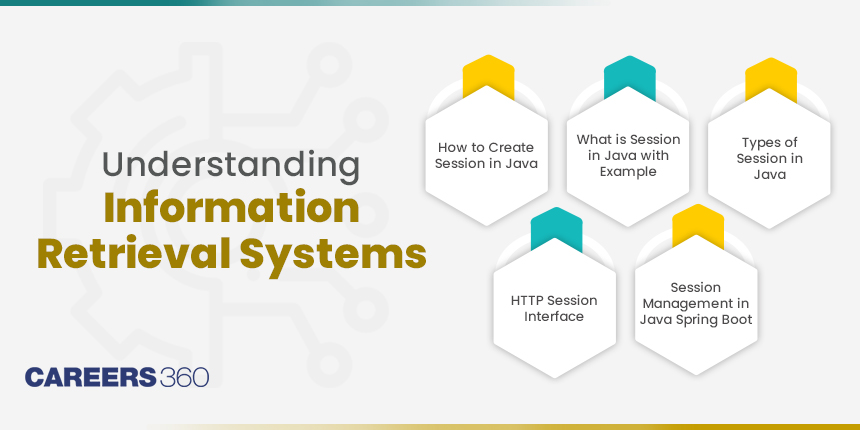Manav Rachna University | B.Sc Admissions 2025
Admissions open for B.Sc. (Hons.)- Chemistry, Mathematics, Physics & more
In the rapidly evolving digital landscape, where information reigns supreme, the efficiency of retrieving relevant data has become a cornerstone of effective data management. Enter the Information Retrieval System (IRS), a linchpin in the world of digital organisation and accessibility. This article aims to unravel the complexities surrounding IRS, exploring their diverse types, comparing functionalities, and dissecting the fundamental components that make them indispensable.

If you are interested in learning more about this field, you can go through some of the Database Management Certification Courses listed on our website.
Information Retrieval (IR) and Data Retrieval (DR) serve distinct purposes. IR focuses on retrieving contextually relevant data, emphasising meaningful information extraction. In contrast, DR involves the broader process of obtaining any stored data, irrespective of its relevance or context.
Also Read:
Understanding the inner workings of an IRS requires insight into its components. These include:
The gateway through which users interact with the system, inputting queries and receiving results.
Definition: The interface facilitating user-system interactions.
Function: Allows users to input queries and receive results.
Responsible for translating user queries into a format the system can understand and process.
Definition: Translates user queries into a format understandable by the system.
Function: Prepares queries for further processing by the system.
Also Read:
Definition: Creates and maintains an index for efficient data retrieval.
Function: Enhances retrieval speed by organising and indexing information.
The repository is where the actual information is stored, organised, and indexed for efficient retrieval.
Definition: Repository where information is stored, organised, and indexed.
Function: Houses the actual data for retrieval.
The primary objectives of an IRS include providing timely, relevant, and comprehensive information in response to user queries. It aims to streamline the process of accessing data within vast information repositories, aligning user needs with efficient retrieval mechanisms.
Also Read:
Approved by UGC | Robust Placement Assistance
Here are some of the examples of information retrieval systems:
Application: Textual information retrieval.
Functionality: Delivers relevant search results based on user queries.
Application: Document retrieval system.
Functionality: Organises and retrieves documents based on user input.
Application: Cataloging and retrieving library resources.
Functionality: Facilitates systematic retrieval of books and materials.
Process: Users articulate queries to the system.
Importance: Initiates the retrieval process.
Process: Translates user queries into a format for system understanding.
Importance: Prepares queries for matching with indexed information.
Process: System matches queries with the indexed data.
Importance: Determines relevance and retrieves matching information.
Process: Delivers a set of relevant results to the user.
Importance: Concludes the retrieval process.
Definition: The system's accuracy in returning relevant results.
Importance: Ensures users receive information directly related to their queries.
Definition: The system's ability to retrieve all relevant documents.
Importance: Ensures comprehensive retrieval of relevant data.
Definition: The speed at which the system processes the inputs and delivers results, in the requested format.
Importance: Affects user experience; faster response times are desirable.
Definition: The intuitiveness of the interface for user-friendly interactions.
Importance: Enhances user experience, encouraging engagement.
Focus: Retrieval of textual information.
Application: Commonly used in search engines.
Focus: Retrieval of images based on visual content.
Application: Useful in image databases.
Focus: Retrieval of audio files.
Application: Applied in music or voice databases.
Definition: Utilises logical operators for query refinement.
Application: Enhances precision in search queries.
Definition: Represents documents and queries as vectors in multi-dimensional space.
Application: Measures similarity for effective retrieval.
Trait: Ability to evolve and adapt to changing user needs and data landscapes.
Significance: Ensures continued relevance and usability.
Trait: Capacity to handle growing data volumes on demand and user queries.
Significance: Maintains efficiency in the face of increasing demands.
Trait: Responsiveness and interactivity of the user interface.
Significance: Enhances user engagement and satisfaction.
Related: Database Management Certification Courses by Top Providers
Information Retrieval Systems play a pivotal role in managing and accessing vast digital information. Their types, components, and functionalities collectively contribute to streamlining the process of obtaining relevant data in the digital age. As we navigate this intricate landscape, understanding the nuances of the IRS empowers us to make informed decisions in an era dominated by information abundance.
Information Retrieval (IR) focuses on retrieving contextually relevant and meaningful data, while Data Retrieval (DR) is a broader term encompassing the process of obtaining any stored data, irrespective of its relevance or context.
An IRS comprises essential components such as the User Interface, Query Processor, Indexer, and Database. These elements work in harmony to facilitate user interactions, process queries, create indexes, and store/retrieve information.
The main objectives include providing timely, relevant, and comprehensive information in response to user queries. An IRS aims to streamline the process of accessing data within vast information repositories, aligning user needs with efficient retrieval mechanisms.
Yes, common examples include Google Search for textual information, Microsoft SharePoint for document retrieval, and library catalogue systems for organising and retrieving library resources. These systems demonstrate the diverse applications of IRS across various domains.
Effective IRS characteristics include adaptability to evolving user needs and data landscapes, scalability to handle growing volumes of data and user queries, and interactivity through a responsive user interface. These traits ensure continued relevance and usability in a dynamic digital landscape.
Application Date:11 November,2024 - 08 April,2025
Ranked amongst top 3% universities globally (QS Rankings)
MSc Finance and MSc International Management Admissions 2025 Now Open | Ranked Among the Top 100 Universities in the World by QS World University Rankings 2025)
Ranked amongst top 3% universities globally (QS Rankings)
B.Sc (Hons) Admissions 2025 Now Open | Ranked Among the Top 100 Universities in the World by QS World University Rankings 2025)
#10 in India by NIRF Ranking | Institution of Eminence by Govt. of India | Scholarships Available
Ranked #1 Among all Private Indian Universities in QS Asia Rankings 2025 | Scholarships worth 210 CR